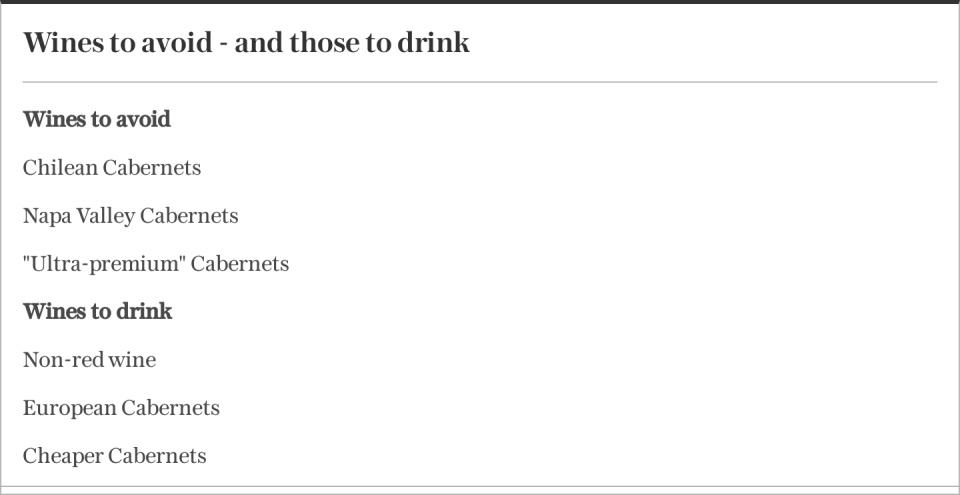The wines to avoid if you don't want a headache, according to scientists

Scientists believe they have finally identified the chemical which is to blame for red wine headaches and flushes.
It is called quercetin, which is part of a group called flavonoids that are found in high quantities in grapes. They are responsible for many of the touted health benefits of wine but quercetin has now been shown to inhibit an enzyme called ALDH2, which the body uses to break down alcohol. As a result, it allows toxic chemicals to build up.
In other drinks, such as beer or cider, there is no quercetin so the body can naturally break down the ethanol unimpeded. However, when red wine is processed by the body any quercetin blocks this enzyme from working properly.
As a result, levels of acetaldehyde, a toxic chemical made from the processing of alcohol which is normally rapidly flushed out of the system, is left to accumulate. Symptoms of high levels of acetaldehyde include flushes, headaches and nausea.
“When quercetin gets in your bloodstream, your body converts it to a different form called quercetin glucuronide,” said Andrew Waterhouse, professor emeritus at the University of California Davis. “In that form, it blocks the metabolism of alcohol.”
Laboratory studies of the chemical and the enzyme reveal that a standard glass of wine, around 150ml, is enough to inhibit about 37 per cent of the activity of ALDH2.
Other foods, including onions, have higher concentrations of quercetin and the operation of the enzyme will also be affected by them. However, in these instances there is no alcohol involved and therefore no acetaldehyde to cause discomfort.

“We postulate that when susceptible people consume wine with even modest amounts of quercetin, they develop headaches, particularly if they have a pre-existing migraine or another primary headache condition,” said study co-author Prof Morris Levin.
“We think we are finally on the right track toward explaining this millennia-old mystery.
“The next step is to test it scientifically on people who develop these headaches, so stay tuned.”
The academics are now planning a Phase 3 clinical trial to test the theory on volunteers.
Researchers said there are still many unknowns about the causes of red wine headaches and add that it is unknown why some people are more prone to them than others. It is possible some people’s enzymatic function is more easily inhibited than others or that some have a higher tolerance for acetaldehyde.
“If our hypothesis pans out, then we will have the tools to start addressing these important questions,” Prof Waterhouse said.
One potential experiment touted in the journal Scientific Reports is to give people wines with different chemical compositions to see if there is a pattern in who gets headaches.
Exposure to sunlight
“Another, simpler, experiment would be to provide red wine headache subjects with a quercetin supplement or placebo and a standard drink of vodka, to see if headaches result,” the scientists said.
Sam Linter, director of wine at Plumpton College, told The Telegraph this study could lead to “the development of grape vine varietals that may naturally produce low volumes of quercetin”.
Ms Linter added that Britain, as a cool climate producer of wine, could be an ideal place to grow these low-quercetin wines that may be headache free.
One study found that high-end wines have four times as many flavonoids as cheap, mass produced wines, probably because of trellised vines, crop thinning and leaf removal, all of which increase the sunlight reaching the grapes and lead quercetin production to soar.
“But, the variations in levels arise not just from differences in grape composition induced by sun exposure but also from wine-making techniques, including skin contact during fermentation, stabilisation/fining procedures, and ageing methods,” the authors said.
Dr Tom Collins, a leading viticulturist from Washington State University who was not involved in the study, told The Telegraph: “Grapevines make quercetin in response to sun exposure, as a sunscreen of sorts.
“Quercetin is present in other plant based foods as well, including tea, kale, broccoli, onions, and many fruits, where presumably the quercetin glucuronide would also inhibit the enzyme, but in the absence of ethanol, there without significant impact.
“Any future clinical study would need to control for diet as in addition to the quercetin in the wines consumed.”
Recommended
What’s really causing your headache – and how to treat it


